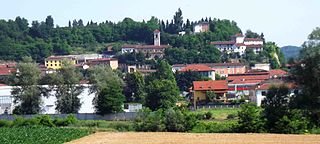
Rocca San Felice is a town and comune in the province of Avellino, Campania, southern Italy.

Albugnano is a comune (municipality) in the Province of Asti in the Italian region Piedmont, located about 20 kilometres (12 mi) east of Turin and about 25 kilometres (16 mi) northwest of Asti.

Baldichieri d'Asti is a comune (municipality) in the Province of Asti in the Italian region Piedmont, located about 35 kilometres (22 mi) southeast of Turin and about 9 kilometres (6 mi) west of Asti. As of 31 December 2004, it had a population of 1,000 and an area of 5.2 square kilometres (2.0 sq mi).
Camerano Casasco is a comune (municipality) in the Province of Asti in the Italian region Piedmont, located about 30 kilometres (19 mi) southeast of Turin and about 13 kilometres (8 mi) northwest of Asti.
Chiusano d'Asti is a comune (municipality) in the Province of Asti in the Italian region Piedmont, located about 35 kilometres (22 mi) southeast of Turin and about 11 kilometres (7 mi) northwest of Asti. As of 31 December 2004, it had a population of 236 and an area of 2.5 square kilometres (0.97 sq mi).

Cocconato is a comune (municipality) in the Province of Asti in the Italian region Piedmont, located about 25 kilometres (16 mi) east of Turin and about 25 kilometres (16 mi) northwest of Asti.It is a member of the I Borghi più belli d'Italia association.

Cortandone is a comune (municipality) in the Province of Asti in the Italian region Piedmont, located about 30 kilometres (19 mi) southeast of Turin and about 13 kilometres (8 mi) northwest of Asti. As of 31 December 2019, it had a population of 308 and an area of 5.02 square kilometres (1.94 sq mi).

Cortazzone is a comune (municipality) in the Province of Asti in the Italian region Piedmont, located about 30 kilometres (19 mi) southeast of Turin and about 14 kilometres (9 mi) northwest of Asti.
Cossombrato is a comune (municipality) in the Province of Asti in the Italian region Piedmont, located about 35 kilometres (22 mi) east of Turin and about 12 kilometres (7 mi) northwest of Asti. As of 31 December 2004, it had a population of 493 and an area of 5.3 square kilometres (2.0 sq mi).

Moncucco Torinese is a comune (municipality) in the Province of Asti in the Italian region Piedmont, located about 20 kilometres (12 mi) east of Turin and about 30 kilometres (19 mi) northwest of Asti.

Montabone is a comune (municipality) in the Province of Asti in the Italian region Piedmont, located about 70 kilometres (43 mi) southeast of Turin and about 25 kilometres (16 mi) southeast of Asti. As of 31 December 2004, it had a population of 357 and an area of 8.5 square kilometres (3.3 sq mi).

Montechiaro d'Asti is a town and comune (municipality) in the Province of Asti in the Italian region Piedmont, located about 35 kilometres (22 mi) east of Turin and about 13 kilometres (8 mi) northwest of Asti.

Nizza Monferrato is a comune (municipality) in the Province of Asti in the Italian region of Piedmont, located about 60 kilometres (37 mi) southeast of Turin and about 20 kilometres (12 mi) southeast of Asti.
Serole is a comune (municipality) in the Province of Asti in the Italian region Piedmont, located about 70 kilometres (43 mi) southeast of Turin and about 40 kilometres (25 mi) south of Asti. As of 31 December 2004, it had a population of 166 and an area of 11.8 square kilometres (4.6 sq mi).
Settime is a comune (municipality) in the Province of Asti in the Italian region Piedmont, located about 35 kilometres (22 mi) southeast of Turin and about 10 kilometres (6 mi) northwest of Asti. As of 31 December 2004, it had a population of 561 and an area of 6.7 square kilometres (2.6 sq mi).
Tonco is a comune (municipality) in the Province of Asti in the Italian region Piedmont, located about 40 kilometres (25 mi) east of Turin and about 13 kilometres (8 mi) north of Asti. As of 31 December 2004, it had a population of 895 and an area of 11.8 square kilometres (4.6 sq mi).

Casalnoceto is a comune (municipality) in the Province of Alessandria in the Italian region Piedmont, located about 100 kilometres (62 mi) east of Turin and about 30 kilometres (19 mi) east of Alessandria.

Montechiaro d'Acqui is a comune (municipality) in the Province of Alessandria in the Italian region Piedmont, located about 70 kilometres (43 mi) southeast of Turin and about 40 kilometres (25 mi) southwest of Alessandria.

Grosio is a comune (municipality) in the Province of Sondrio in the Italian region of Lombardy, located about 130 kilometres (81 mi) northeast of Milan and about 35 kilometres (22 mi) northeast of Sondrio, on the border with Switzerland.

Casorate Primo is a comune (municipality) in the Province of Pavia in the Italian region Lombardy, located about 20 kilometres (12 mi) southwest of Milan and about 20 kilometres (12 mi) northwest of Pavia.

















